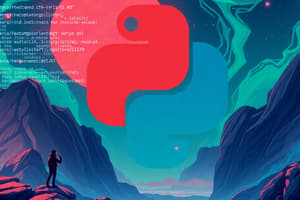Podcast
Questions and Answers
What does Python use instead of curly brackets to indicate program structure?
What does Python use instead of curly brackets to indicate program structure?
- Indentation with whitespace (correct)
- Semicolons
- Braces
- Square brackets
Which data type in Python represents true or false values?
Which data type in Python represents true or false values?
- String
- List
- Boolean (correct)
- Numeric
Which data type in Python is used for ordered collections of mutable objects?
Which data type in Python is used for ordered collections of mutable objects?
- Tuple
- List (correct)
- Numeric
- String
In Python, what does the Tuple data type have that lists do not?
In Python, what does the Tuple data type have that lists do not?
What is one feature that distinguishes Python from many other programming languages in terms of syntax?
What is one feature that distinguishes Python from many other programming languages in terms of syntax?
Which of the following is NOT a valid Python data type?
Which of the following is NOT a valid Python data type?
What Python construct is used to map keys to values?
What Python construct is used to map keys to values?
Which control flow construct in Python allows you to iterate over a sequence?
Which control flow construct in Python allows you to iterate over a sequence?
What is the purpose of the 'import' statement in Python?
What is the purpose of the 'import' statement in Python?
Which keyword is used to define a function in Python?
Which keyword is used to define a function in Python?
What does an 'if' statement in Python primarily test for?
What does an 'if' statement in Python primarily test for?
Which data type in Python allows only unrepeatable values?
Which data type in Python allows only unrepeatable values?
Flashcards are hidden until you start studying
Study Notes
Introduction
Python is a versatile and popular high-level programming language known for its simplicity and ease of use. It was developed in the late 1980s and released in 1994. Python combines an elegant and eminently clear design with remarkable consistency across implementations, making it suitable for a variety of applications such as web development, scientific computing, artificial intelligence, machine learning, and data analysis.
In this article, we will discuss the basic concepts of Python, including its syntax, data types, control flow, modules, and functions. By the end of this article, you will have a solid understanding of these key aspects of the language.
Syntax
Python's syntax is designed to be easy to understand and use. It supports a variety of data types, including integers, floats, strings, lists, dictionaries, and more. Python uses whitespace, rather than curly brackets, to indicate program structure. This unique approach eliminates the need for semicolons and reduces the complexity of the language.
Data Types
Python offers several data types, which are classified into the following categories:
- Numeric: Represents numerical values, including integers and floating-point numbers.
- String: Represents sequences of characters, enclosed in single or double quotes.
- Boolean: Represents true or false values, denoted by
TrueorFalse. - List: Ordered collections of mutable objects.
- Tuple: Similar to lists but immutable.
- Set: Unordered collections of unrepeatable values.
- Dictionary: Maps keys to values.
Here's an example of how you might use these data types:
## Numeric types
num = 10
float_num = 5.0
## String type
string = "Hello, World!"
## Boolean type
bool_val = True
False_val = False
## List type
my_list = [1, 2, 3]
## Tuple type
my_tuple = (1, 2, 3)
## Set type
my_set = {1, 2, 3}
## Dictionary type
my_dict = {"Name": "John", "Age": 25}
Control Flow
Control flow in Python refers to the sequencing of instructions in a program. It determines how programs process input and produce output. Python provides several control flow constructs, namely if, elif, else, for, while, break, continue, and pass.
For example:
## Conditional statement
if num > 5:
print("Number is greater than 5.")
else:
print("Number is less than or equal to 5.")
## Looping structure
for item in my_list:
print(item)
The if statement tests whether a condition is true or false, and elif (short for "else if") allows to check multiple conditions without excessive indentation. The for loop iterates over a sequence, allowing you to execute commands for each item in the sequence.
Modules
Modules are files containing Python definitions and statements. They provide a means of organizing code into logical units and can be imported into your own programs. For example, you might import the math module to access mathematical functions:
import math
print(math.sqrt(25)) # Output: 5.0
Functions
Functions are reusable blocks of code that perform specific tasks. In Python, function users define functions using the keyword def. Here's an example of defining and calling a function:
def greet():
print("Hello!")
greet()
In this code snippet, we define a function called greet, which prints the string "Hello!" when invoked. We then call the greet function, resulting in the specified message being displayed.
This concludes our overview of the key aspects of Python programming. By learning these concepts, you will be well-equipped to start writing your own Python code and understanding more advanced topics.
Studying That Suits You
Use AI to generate personalized quizzes and flashcards to suit your learning preferences.




